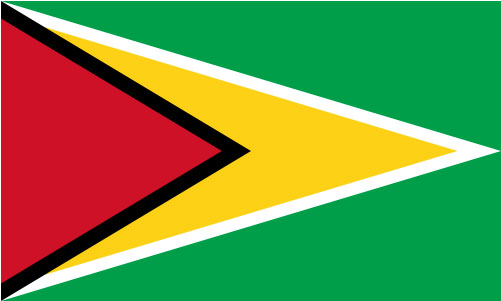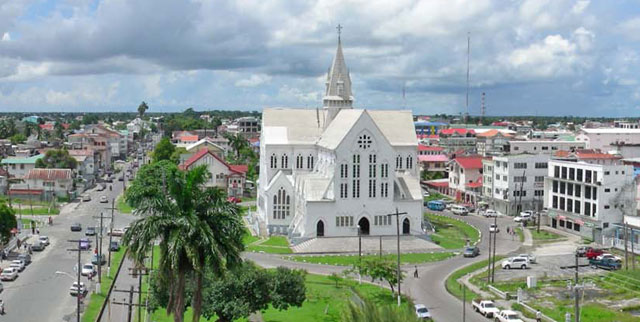Georgetown is a Floral Gem
By Surendra Mohabeer
Bronx Journal Staff Writer
Originally published Fall 2007
It is the capital of Guyana, South America, a tropical paradise, and the city where I was born: my beloved Georgetown. You may have heard of nearby cities – Caracas, Venezuela; Bridgetown, Barbados; Kingston, Jamaica. But you may not be familiar with my hometown.
On the northern coast of South America, facing the Atlantic Ocean, Georgetown is culturally more akin with the Caribbean islands. The city lies five feet below sea level, and is protected from floods by a lengthy sea wall, built in 1882.
As you walk the streets of the town, you see homes and buildings that are raised on brick and solid wood stilts to protect them from flooding. Even the University of Guyana, located on the city’s outskirts, is on stilts.
Guyana does not go through four distinct seasonal changes a year, like here in North America. The country experiences only two kinds of weather seasons – rainy, from April to August and November to January, and dry the rest of the year.

Georgetown Parliament
However, because the country is located in South America and is above the Equator line, the temperature is always mild, and the trade winds blowing off the Atlantic Ocean help in cooling off the heat of the dramatic sun.
The climate provides a wonderful environment for foliage; in fact Georgetown was once known as the Garden City. The Botanical Garden is a favorite destination for Georgetown residents.
The population is multiracial, consisting of East Indians, Amerindians, Afro-Guyanese, Chinese, Portuguese and Europeans, reflecting the country’s history of indigenous culture, Asian indentureship, African slavery, and European migration and colonialism.

In 1981, I was born in the Georgetown Hospital. But I grew up in a town called Vreed-En-Hoop, a few miles away. I came to America in 1990, and have lived in Brooklyn for over 15 years. In December 2004, my family and I went on a two-week vacation to Guyana and I had an opportunity to visit Georgetown for the first time since I left. December is during the rainy season, but that didn’t stop me from having fun.
As I walked down Georgetown’s tree-lined streets, I had flashbacks to when I was a kid and my father would take me there. I remember how exciting it was!
Over the centuries, through successive European wars, Georgetown exchanged colonial hands, from British to French to Dutch and back again. Under the Dutch, Georgetown had been called Stabroek, and the large Dutch-designed building that is the city’s centerpiece, built in the 1880s, is still called Stabroek Market. This structure is inspired by the Dutch architecture and features a massive cast-iron clock tower that dominates Georgetown’s skyline. Guyana still carries the mark of Dutch influence in much of its architecture and landmark names.

The British developed Georgetown most extensively, after capturing it from the Dutch in 1781. They renamed it after the British King George III. The British ruled the entire country under the name British Guiana until independence in 1966. Because of this history, Guyana is the only English-speaking country in South America.
In Georgetown, I passed by many marketplaces that line the streets with stalls. When I stopped to see what was being sold, I saw fresh mangos, watermelons, papayas, cashews and other exotic nuts and fruits. There were also garden vegetables, meat products, and a host of spices. We ended up at Boarda Market, which is located at the ferry port, the Guyanese version of a mall.
My father told me that when my sister and I were younger, either he or my mother would take us there to visit my grandmother, who used to sell goods for a living. My grandmother would spoil us with fresh fruits to snack on, and just like any other grandma, a handful of candy to take home.

St. George's Cathedral
My oldest cousin drives a bus in the city, so he picked us up and took us to a pool hall called Buddy’s Guyana’s Entertainment Center. We all drank the local Banks beer, relaxed, and shot some pool. We ate at Mei Tung restaurant, one of the many local Chinese eateries, and the food was excellent.
One day, I visited The National Library of Guyana, housed in a huge white stone building. From the outside it looks small, but, like they say, don’t judge a book by its cover.
Another attraction is the Georgetown Lighthouse, widely acknowledged as one of the most striking in the area. In 2003, a team of conservationists from the Smithsonian Institution cleaned and restored the clockwork mechanism that rotates the lighthouse’s lens.
There are many churches, mosques and mandirs, or Hindu temples, in Georgetown. The white washed St. George’s Cathedral is the tallest wooden building in the world.

Georgetown at night. (madmack66)
Regent Street is known as Georgetown’s main shopping district. Sheriff Street is where the action is for nightlife.
While I was in Georgetown, every night was like a party. All our friends and relatives would come over to where we were staying. Soca music blasted as we danced the night away, drinking our tropical beverages, and eating good home-cooked food.
The kids would play their games; the women would be talking and laughing about their affairs; and the men would be relaxing and reminiscing about how things were, back in the day. They all agree that Georgetown, and Guyana in general, has changed a lot. It has many economic challenges leading lots of Guyanese, my family included, to emigrate from their beloved country.
But nobody can deny that Georgetown is still a city with energy and sprite. It really is the Manhattan of the West Indies.
Images: Flickr.com
Page Designed by Junior Galeas

